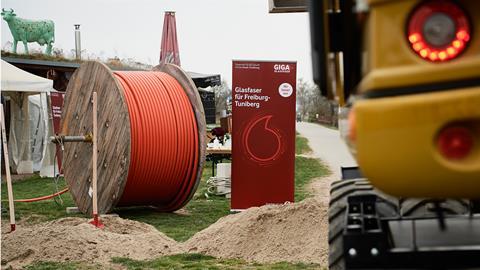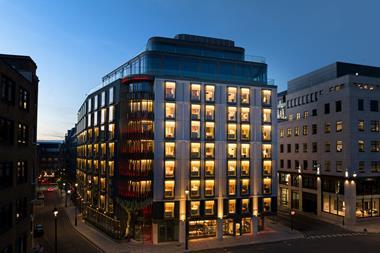How and why there is an opportunity for real estate firms to supply fiber optic cables to broadband internet operators? Read on.

When real estate investors think of digital communication infrastructure, perhaps the first images that come to mind are those of mobile telecom masts and data centres.
After all, these past 12 months have seen an explosion in big-ticket transactions, in these areas. Indeed, of the 20 largest real estate transactions of 2021, several were in these two categories.
However, outside this sphere is a third category of digital infrastructure which seems to get relatively less attention.
Given the important part fiber cables play in digital infrastructure, it is surprising it is not spoken more of. As the internet grows ever more powerful, fuelling business growth and personal leisure time, you would think investors in real estate assets could not afford to overlook returns from the development of the fiber network.
Fiber optic cables (“fibre” in British spelling) have been around for decades, so they are not new. They are preferred to copper networks for being relatively inexpensive in comparison, and for being better at carrying signals for longer distances, while also cutting electromagnetic interference.
These cables are made out of incredibly pure glass drawn into very thin strands (though sometimes plastic is used). The glass is coated in two layers of plastic, and what that does is provide the effect of a mirror to create a total internal reflection of photon light particles without actually having to use mirrors inside the cabling. Light bursts that travel through the cable contain coded information which bounces off at shallow angles along the networks to eventually reach the end user.
These laser lights send billions of bits of information per second, and a signal can be carried for maybe up to 100 km at which point another ‘hut’ is required to retransmit the information at the same strength, and so it goes on. This, by the way, is different to mobile phone technology which uses invisible radio waves.
Some cables have only two strands, others 100. Each strand is said to be 1/10th of the width of a human hair. At the other end where a person is at their computer, the pulsing light beams are turned back into electrical information by a photoelectric cell, and therefore words and images ultimately appear on a screen.
Some of the first instances of companies installing fiber cables were in the late 1970s. The first all-optic fiber cable is said to have been laid across the Pacific Ocean in 1996.
Niche within a niche
Perhaps it is unsurprising that very few real estate companies have a specialisation in fiber cabling. After all, it does not sound like a real estate business. But one that does is Primevest Capital Partners, the Netherlands-based company which has a digital infrastructure business alongside car parks and residential property.
The company launched its first Communication Infrastructure Fund in 2017, giving it a ‘first mover’ advantage and is launching a second fund that aims to amass between €800 mln -€1 bn of assets.
Frank Noé, head of capital formation at the group, says: ‘Fibre optic cable is the backbone of our future economies, the backbone of growth, and decent work environments, and the very information society that the EU is striving for.’
Primevest is involved in the ‘passive’ layer of fiber cables, meaning ‘all’ it does is identify areas of demand, gains the necessary permissions, employs contractors to dig up the ground to lay the cable, and rents it out to an operator such as Vodafone, Deutsche Telekom or NKL on long-term leases. The operators put their own layer of technology onto the fiber network supplied by Primevest to connect their customers.
This ‘real estate business’ is not particularly well understood to those outside it. Therefore, it is little wonder there are several surprises in store for the uninitiated. These include how far countries such as the UK and Germany are behind other countries, particularly in Asia, in terms of the market penetration of fiber optic cables to households and businesses. Hence, the opportunity.
Also, one would have thought that the giant telecoms operators such as Vodafone would not require any help from a real estate infra fund to gain a network. Surely, they do all this themselves? Not so.
In addition, those that have never looked into it, might be surprised to know that operators pay Primevest rent on a monthly basis, meaning there are distributions to investors more regularly than in normal real estate vehicles. Income can possibly be earned much earlier in the development cycle too. ‘Day one’ does not mean when the cable network is fully complete. Sections can be rented out during the construction unlike in a normal development of say, an individual office block.
Major Europe markets way behind
Primevest says it has an acquisition pipeline of €500 mln of fiber cable assets in target markets of the Netherlands, Belgium, Germany and Austria.
If one were to hazard a guess, perhaps you’d say that these four countries would easily be amongst those in the lead globally for already having high-speed full fibre broadband penetration. But no, you would be mistaken.
According to a study by The Organisation for Economic Co-operation and Development released in 2020, these four countries are incredibly low in terms of fiber optic market penetration. The Netherlands sits at 26th in the world on just 17%, one place above the mighty US on 15%. Germany is even lower at 32nd with just 3.5%, Austria 33rd on 2.68%. The UK is even worse in 34th place with 2.33%.
Korea leads the way as the most advanced nation. As of Q2 2019, some 81.65% of Korean fixed broadband connections were on a fiber cable network. Japan follows with 79%. It turns out that in Europe, Lithuania is top (74%), followed by Sweden (68%), Latvia (68%) and Spain (62%).
No study is perfect, but the OECD data broadly reflects other rankings. Statista, for example, reports that in Europe, the leading countries for fiber-to-the home and to the building penetration is Belarus (68%), Spain and Sweden (62%). Again, Germany, the Netherlands and the US are way behind.
Primevest began rolling out fiber cabling in the Netherlands and Germany from 2017.
As one of the first real estate companies to do so, it was clear to Primevest that copper cable networks were reaching their limits. Many operators had established these copper networks and seemed reluctant to abandon that investment for fiber.
Meanwhile, Asian economies forged ahead.
Thus, the average OECD penetration is just 30%, compared to more than 80% in Korea for example.
Says Noé: ‘We have to really speed up to catch up with other regions of the world. We are struggling and losing sight. During Covid, it became even more obvious that working from home and everything else requires bandwidth. We see SMEs in Germany, for example, using e-invoicing to avoid paper. Everything requires a better network.’
The fiber market is extraordinarily active on the corporate front.
Private equity firms have been busy buying incumbent operators, which is now helping push legacy telecoms firms into the modern fiber-optics world. These private equity owners have tended to link asset management with corporate investment in the operators, according to Noé. They may not necessarily have the knowhow or links to grow a network though, so they turn to Primevest.
For the less established incumbents, it can also be a challenge to grow where larger players are already dominant. Such smaller players might not have the access to capital markets to grow, so they also might turn to Primevest.
Capital solution
‘You would think big companies could do it by themselves, but you would be stunned at how they need external “speed boats” compared to their “tanker” to deliver exactly what the business development team needs to compete,’ says Noé. ‘We are the aggregator. We have the ability to talk to the cities. I am German, the majority of the team is German. One needs to get all of the approvals together with the operator and inform the cities that the capital being deployed is German. There is a lot of management, market intelligence and know-how required, which big incumbents are troubled with.
Being independent, Primevest plays the angle of being able to offer its network to all of the operators.
‘It is a real estate-like model,’ says Noé. ‘We roll out the fiber, and put say T-Mobile or Vodafone onto it. Three or four years later, we have the possibility to put other incumbents on it. We enhance adoption through offering it to other operators on an “open access” model. The operator can come in and add their tech. We just provide the backbone – the infrastructure.’
He adds: ‘There is a longevity to the product. Fiber cables can last 30 to 40 years. You don’t have to touch it. There is also empty additional space to add in more fiber even without digging again.’
Greenfield sites
There is another (slightly) surprising element to this business which needs clarifying. Perhaps it is just one of terminology, but Noé explains that the fund seeks ‘greenfield’ sites as the starting point for a new network.
In Germany, a lot of the “backbone” telecoms infrastructure is located around railway stations and tracks. ‘Greenfield in this context are still places where people live. It is about connecting a network to the backbone that already exists,’ he says.
Incumbents always start their networks in more rural areas – not farmland, but where there is no proper cable.
Incumbents are selling their vision to customers of being able to have video calls without the connection breaking up. The networks have to be close to cities but with a demographic profile that is not too elderly.
When operators think of being in ‘proximity’ to a city, that can mean up to 100 km away. The idea would be to start by building near a village, and from that village into the next and the next, ultimately arriving at the city centre.
They have ‘pop-ups’ for the villages and sub pop-ups in the streets to support the entire network. In the Netherlands, a lot of cities are finally being connected, right down to individual apartments.
Primevest buys the fiber cable from whatever domestic supplier is good. Construction begins. But it seems the beauty of the financial model is there is no ‘hockey stick’ to it.
After 9, 12 or 15 months of construction, distributions to Primevest investors are possible because the incumbent operator starts connecting customers per section. The operator has to pay Primevest rent no matter how successful or not sales have been. That said, Primevest does not like renting to start-ups, but rather companies already in growth mode that can afford the minimum rent at the beginning of the roll-out, equalling normally a 3%-4% yield.
Sector consolidation
Noé further explains how Primevest earns a management fee upon invested capital (not uninvested). How can the firm justify or earn the management fee if it has already leased the network to an operator, though? The answer is that there is indeed ongoing asset management work. The business might have leased the network to, say, Vodafone on a long lease. However, for a couple of years the landlord has the right to bring other operators onto the same network. This, by the way, avoids constantly building and digging up.
‘We are trying to connect cities, densify, and penetrate networks further. To this extent, we are also building our exit scenario,’ says Noé .
It has not escaped Primevest’s attention that consolidation will come to this sector given the activity by private players. This is going to play into its hands if it can build valuable networks used by them. ‘As always, at some point all these operators will consolidate at some point. The more we have, the better the consolidation roadmap will look, and the bigger value our network will have,’ observes Noé.
The roll-out is clearly a hectic time in the lifespan of the fund, but management doesn’t stop once construction stops. Primevest’s plan involves ultimately adding data centres to the network.
Which brings up another question. Given data centres and telecoms masts are already niche, why concentrate on fiber – a niche within a niche? Well, part one of the answer is expense. Take the mobile phone antenna market for example. First, prices are so high it puts a question mark over whether the yield is enough.
Second, it seems that the portfolios coming up for sale have been big – not less than €200 mln which would make Primevest’s fund out of kilter should it buy one. That said, the company has just put an indicative bid in on a portfolio in Germany. However, it has done so with a German insurance company that is putting up 80% of the capital as co-investment.
Meanwhile, prices for data centres are also extremely high amid fierce interest. But as previously stated, the firm is looking to add data centres and masts to its fiber networks when the opportunities present themselves.
For its fiber assets, a lot of yield shift has taken place already, increasing the value of Primevest’s assets. For the new fund, the firm has an 8-10% target IRR but believes it can deliver low-teen IRRs even though it is a ‘core product’ with a stable 5-6% cash flow yield after the investment period. The first fund has delivered runs on an IRR above 12% currently.
The market will be watching closely. Not only that, but so will businesses and ordinary citizens. For once, one can say their lives very much depend upon it.
Fiber news: VODAFONE GERMANY, PRIMEVEST AND NOKIA TEAM UP
Vodafone Germany announced in late March that it is working with Primevest Capital Partners and Nokia on the roll-out of a high-speed gigabit internet for the Tuniberg municipalities. The fiber-optic cables will connect around 5,300 households and businesses in Opfingen, Munzingen and Tiengen around the Tuniberg near Freiburg.
Primevest Communication Infrastructure Fund is financing the fiber roll-out, which will be built by Nokia. Vodafone is operating the network, supplying the fiber-optic connections, and providing the high-speed gigabit internet, television and telephony services.
Rolf-Peter Scharfe, head of fiber-optic cooperations at Vodafone Germany, said: ‘Successful pre-marketing has shown that there is a pressing need for high-speed internet.’
Vodafone added: ‘As a gigabit company, Vodafone is the driving force behind infrastructure expansion in Germany and has already reached more than 24 million households over their national fiber-optic network, of which approximately 23 million are at gigabit speeds.’
‘By the end of the year, Vodafone will provide two-thirds of Germany’s inhabitants with gigabit connections. In doing so, it relies on a technology mix of cable and fibre optics with an investment programme that not only improves the entire cable network in the present coverage area, but also with other programmes that boost fiber-optic expansion where it is most needed – in rural areas – both for the inhabitants and for the economy.’









